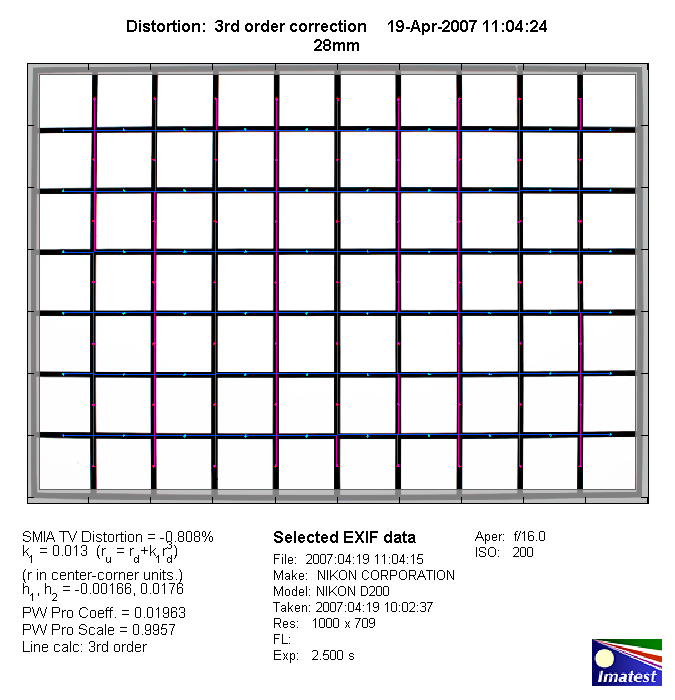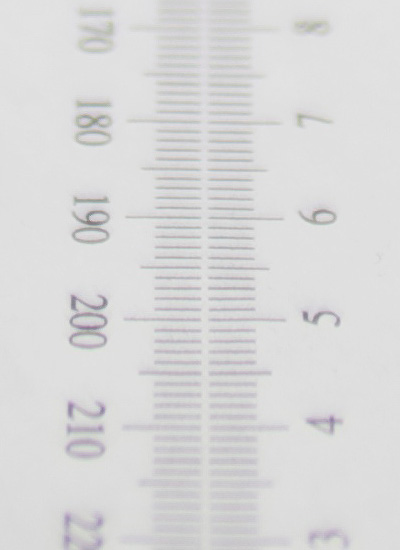|
Page 2 of 2

Distortion
On DX cameras the lens shows only a small amount of barrel distortion.

The chart above has a real-world size of about 120x80cm.
Vignetting
Being a FX lens, the Nikkor profits from the sweet spot advantage on DX cameras and consequently shows only moderate vignetting wide open, which is reduced to an irrelevant level at f/2.8 and beyond.

MTF (resolution)
The center resolution is very good already at the largest aperture. However the lens shows reduced contrast at this aperture setting as well as what is often described as "glow" around contrast edges. This behaviour is typical for many classical ultra-fast lenses. Stopped down, the resolution (and contrast) increases and reaches excellent level from f/2.8 onwards.
The borders and corners follow a good deal behind, with only poor to fair resolution at large apertures. The lens needs to be stopped down considerably to achieve very good resolution here. The performance peak at the borders and corners is reached at f/8.
Please note that the MTF results are not directly comparable across the different systems!
Below is a simplified summary of the formal findings. The chart shows line widths per picture height (LW/PH) which can be taken as a measure for sharpness.
If you want to know more about the MTF50 figures you may check out the corresponding Imatest Explanations

Chromatic Aberrations (CAs)
Chromatic aberrations (color shadows at harsh contrast transitions) are moderate with an amount of roughly 1 to 1.7 pixels at the image borders.
CAs can easily be corrected in software or by the camera itself (most modern Nikon DSLRs remove CAs themselves if you shoot JPGs).

Bokeh
One of the primary usage scenarios for a large aperture lens is to separate the main subject from the background. In such an image the quality of the bokeh (out-of-focus blur) is of major significance.
Thelens shows a somewhat nervous blur characteristic, especially in the transition zone.
Background highlights show a cat's eye shape due to mechanical vignetting at the largest aperture, which is typical for fast lenses. In addition, there's a fair amount of outlining, which increases the impression of nervousness. Stopped down, the outlining is reduced, but the shape of the aperture blades becomes visible.

Bokeh Fringing
Bokeh fringing (non-coinciding focal planes of the various colors) is a common issue with relatively fast glass. As you can
notice below, the halos have different colors - magenta (red + blue) in front the focus point
and green beyond. Truly "apochromatic" lenses don't show this kind of fringing but these lenses are very rare especially
below 100mm. Unlike lateral lateral CAs, bokeh fringing cannot easily be fixed in post processing.
Typical for most fast primes, especially ultra fast ones, the AF-D 28/1.4 shows some amount of fringing at large aperture settings, which can of course be reduced by stopping down.
In addition, these shots show the "glow" around contrast edges as well as the lack of contrast at large apertures (which is pronounced in these images due to the very short focus distance) as already mentioned in the MTF section.
|
Move the mouse cursor over the f-stop marks below to observe the respective LoCAs
|
| f/1.4 |
f/2 |
f/2.8 |
f/4 |
f/5.6 |
|

|
Sample Images
You can find some sample images taken with the Nikon D3x in our Nikon FX review of the lens.
Verdict
The Nikkor AF-D 28mm f/1.4 delivers mostly solid performance on our DX test camera, however it is not without flaws. Sharpness is very good in the image center wide open already and excellent when stopped down. However, at large apertures the lens lacks contrast and shows a "glow" around contrast edges that's typical for many classic fast lenses. The borders and corners struggle on the high density DX sensor, the lens needs to be stopped down considerably to achieve very good sharpness here.
As to be expected from a FX lens on a DX camera, vignetting and distortion are no issues for most subjects. CAs are moderate, but can easily be corrected in post processing anyway. The bokeh is a bit nervous, which is quite typical behaviour for a wide angle lens. However, modern lenses, like the Nikon AF-S 24/1.4 show some improvements especially in this regard.
Once targeted at professional users, the build quality is accordingly superb.
When it was current, the lens had no competition. Anyone wanting an ultra-fast wide angle AF lens had no choice but the AF-D 28/1.4 (or lower quality 3rd party options). For DX users looking for a normal prime there are more capable lenses today, not only FX lenses like the Nikon AF-S 24/1.4 or the more affordable Nikon AF-S 28/1.8, but also dedicated DX lenses that cost only a fraction of the used price of a Nikon AF-D 28/1.4.
However, even though it may look a little outdated in direct comparison, it's still an iconic lens and certainly one to have fun with in the field.
|